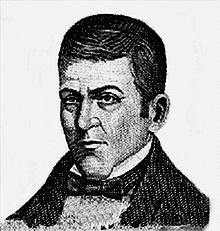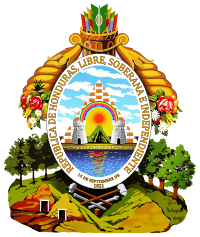José Dionisio de la Trinidad de Herrera y Díaz del Valle
José Dionisio de la Trinidad de Herrera y Díaz del Valle (born October 9, 1781 in Choluteca , Honduras , † June 13, 1850 in San Vicente , El Salvador ) was the first head of state of the province of Honduras and head of state of the province of Nicaragua within the Central American Confederation .
Life
Origin and youth
Dionisio de Herrera was born into a wealthy family in late colonial Central America. His parents were Juan Jacinto de Herrera and Paula Díaz del Valle. He was a cousin of the renowned lawyer and author of the Central American Declaration of Independence José Cecilio Díaz del Valle and a brother of the later head of state of Honduras Justo de Herrera .
Herrera was very educated and built up a very extensive library over time. In addition to his native Spanish, he was also fluent in French. Among other things, he got access to the works of Rousseau , Diderot , Montesquieu and D'Alembert , which made him an enthusiastic supporter of liberal ideas.
After studying law at the Universidad San Carlos de Guatemala , Herrera initially worked in the colonial administration in Tegucigalpa . At the same time, however, he campaigned for Central America's independence from Spain . After the news of the Central American Declaration of Independence, signed in Guatemala City on September 15, 1821 , had reached Honduras, Herrera drafted a declaration of independence for the provinces of Comayagua and Tegucigalpa, which were then still separate, and which was proclaimed simultaneously in both provinces on September 28.
A short time later, however, there was a military confrontation between the traditionally conservative province of Comayagua and the liberal Tegucigalpa over the question of joining Central America to the young Mexican Empire . While the Conservatives supported this, the Liberals campaigned for an independent Central American state modeled on the USA . Despite the resistance of Herrera and his party friends, it was finally annexed to Mexico. However, this ended after almost a year because of the fall of the Mexican Emperor Agustín I. .
Head of State of Honduras
After Central America became independent from Mexico, Herrera was appointed governor of the Tegucigalpa province on March 23, 1823. In this capacity he drove the unification of the provinces Comayagua and Tegucigalpa to the state of Honduras. To this end, a constituent assembly was called which met in the small town of Cedros . With a resolution of September 16, 1824, this assembly carried out the unification of the two provinces and elected Herrera as the first head of state of Honduras. The conservative Lieutenant General José Justo Milla was elected as his deputy .
Together with his nephew Francisco Morazán by marriage , whom he appointed Secretary General of the government, Herrera was the authoritative author of the first constitution of the state, which came into force in 1825 and remained in force until Honduras left the Central American Confederation. This was shaped by Herrera's liberal outlook. Based on the US Constitution, it guaranteed numerous basic rights and also curtailed the rights of the Catholic Church. In addition, the state was divided into seven administrative districts ( Departamentos ).
The coat of arms of Honduras, which is still valid today, was introduced by Dionisio de Herrera in 1825.
However, the liberal policies of his government quickly brought Dionisio de Herrera into conflict with the Catholic clergy , above all the episcopal provisional José Nicolás Irías, who soon assumed very personal features. Among other things, Irías had Herrera's extensive library burned on the grounds that it contained heretical writings. The conflict reached its climax on November 3, 1826 with an assassination attempt on Herrera initiated by Irías, which failed. In response to the attack, Herrera placed Irías under house arrest, which in turn sparked protests and riots by supporters of Irías in several parts of the country. Herrera had this violently suppressed.
At around the same time, however, Herrera came into conflict with the federal government under President Manuel José Arce . In October 1826, in the face of severe criticism from the members of his own (liberal) party at his government policy - contrary to the constitution - the federal parliament was dissolved. This resulted in massive public protests, which Herrera - as well as the head of state of El Salvador Mariano Prado Baca - joined. Arce therefore sent troops under the command of Herrera's deputy, Lieutenant General Milla, to Honduras, which took Comayagua on May 10, 1827 and captured Herrera. Milla took over the affairs of state on an interim basis until an assembly called by him on September 13th declared Herrera deposed and elected new authorities.
Head of State of Nicaragua
Dionisio de Herrera was brought to Guatemala City by the Federation troops, where he remained in custody until Francisco Morazán conquered this city in April 1829.
After his liberation, Herrera was elected head of state of Nicaragua on May 12, 1830 on the initiative of Morazán - who was just preparing to become president of the federation . Herrera's most important task was to bring the conflicts between the liberal León and the conservative Granada under control , which have not ended since independence . Herrera managed to do this quite well for a while. In November 1833, however, he resigned his office and went to El Salvador , where he was also offered the office of head of state the following year, which he refused.
In 1838 Herrera was elected MP and Vice-President of the Constituent Assembly in his home country Honduras, which - against his vote - declared Honduras' withdrawal from the Central American Confederation on November 12th and drafted a new constitution. Disappointed with this political development, he went back to El Salvador after the constitution was passed, where he settled in San Vicente and worked as a teacher and, finally, director of the primary school there until his death.
Honors
Dionisio de Herrera is still highly revered, especially in Honduras. Among other things, one of the highest orders in the country, the “Orden Dionisio de Herrera”, bears his name and he is depicted on the 20 Lempiras banknote. In addition, numerous streets, squares and schools are named after him. His birth house in Choluteca is part of the "National Cultural Heritage".
Web links
literature
- Rodolfo Pastor, Historia de Centroamérica . El Colegio de México , Mexico 1988, ISBN 84-8377-291-4
| predecessor | Office | successor |
|---|---|---|
| - |
Heads of State of the Province of Honduras September 16, 1824-10. May 1827 |
José Justo Milla Pineda |
| Nicolás Espinoza |
Heads of State of the Province of Nicaragua May 12, 1830 – November 1833 |
Benito Rosales |
| personal data | |
|---|---|
| SURNAME | Herrera y Díaz del Valle, José Dionisio de la Trinidad de |
| ALTERNATIVE NAMES | Herrera, Dionisio de |
| BRIEF DESCRIPTION | Head of State of Honduras and Nicaragua |
| DATE OF BIRTH | October 9, 1781 |
| PLACE OF BIRTH | Choluteca , Honduras |
| DATE OF DEATH | June 13, 1850 |
| Place of death | San Vicente , El Salvador |

